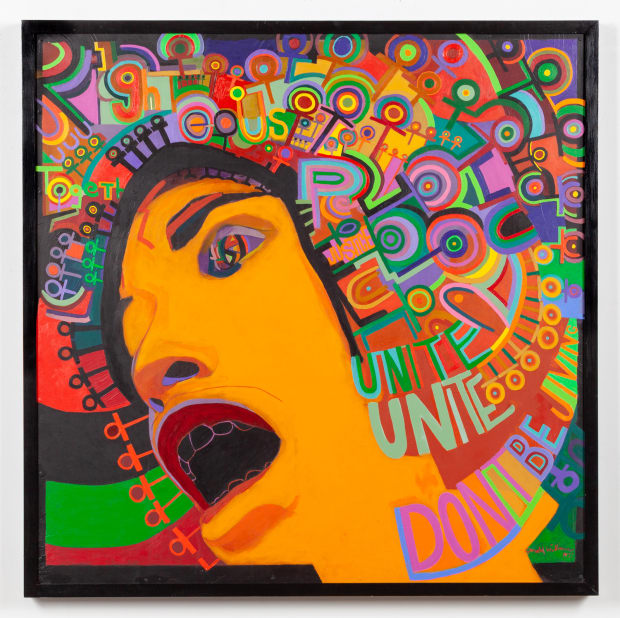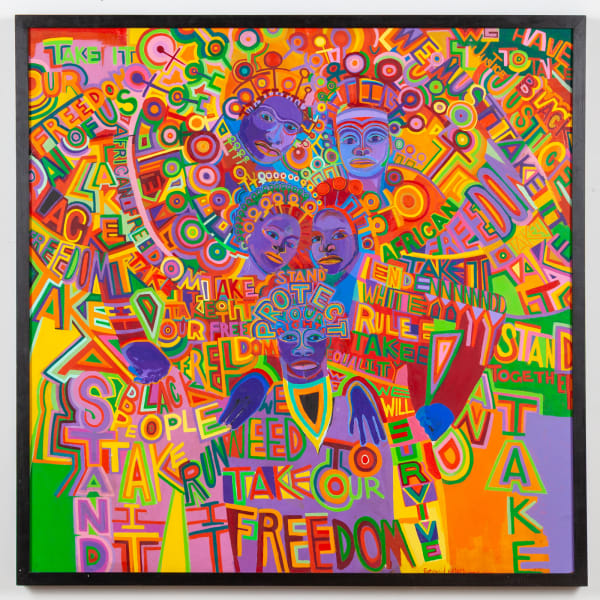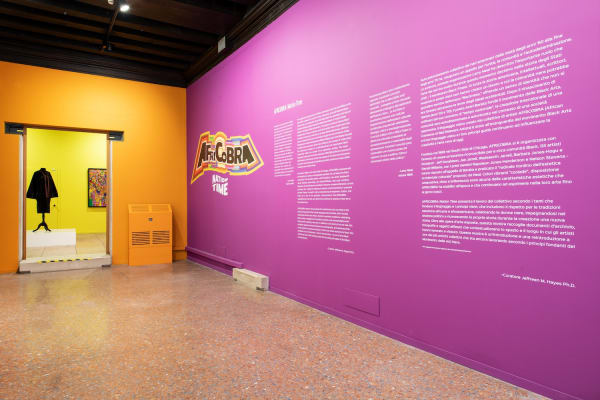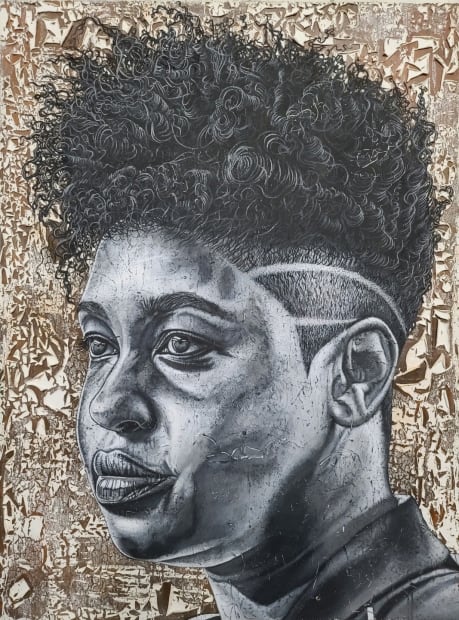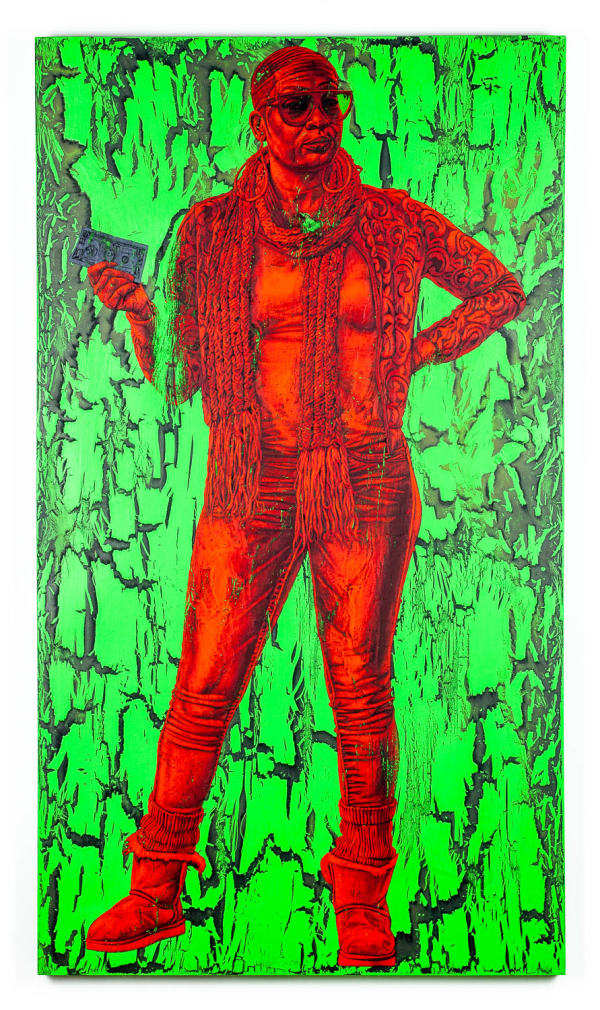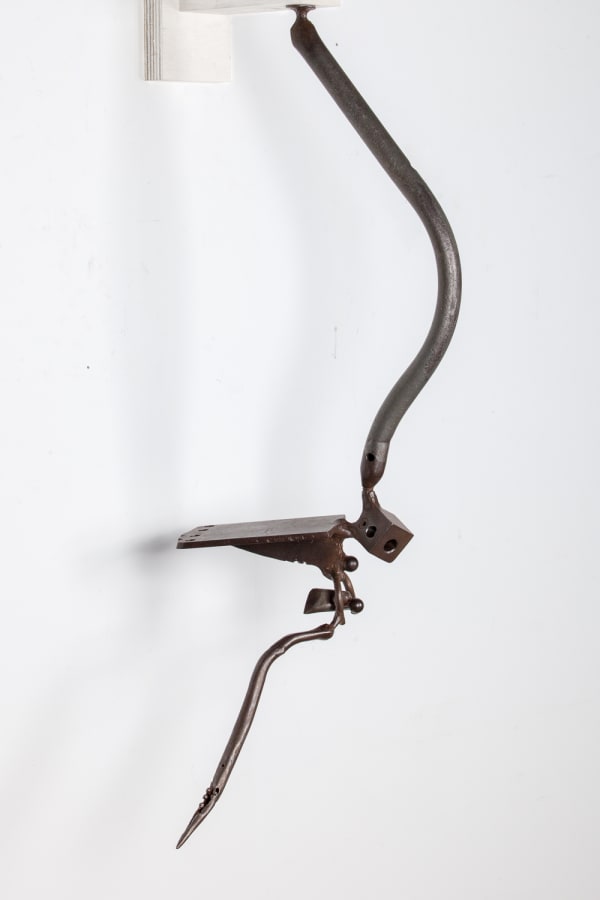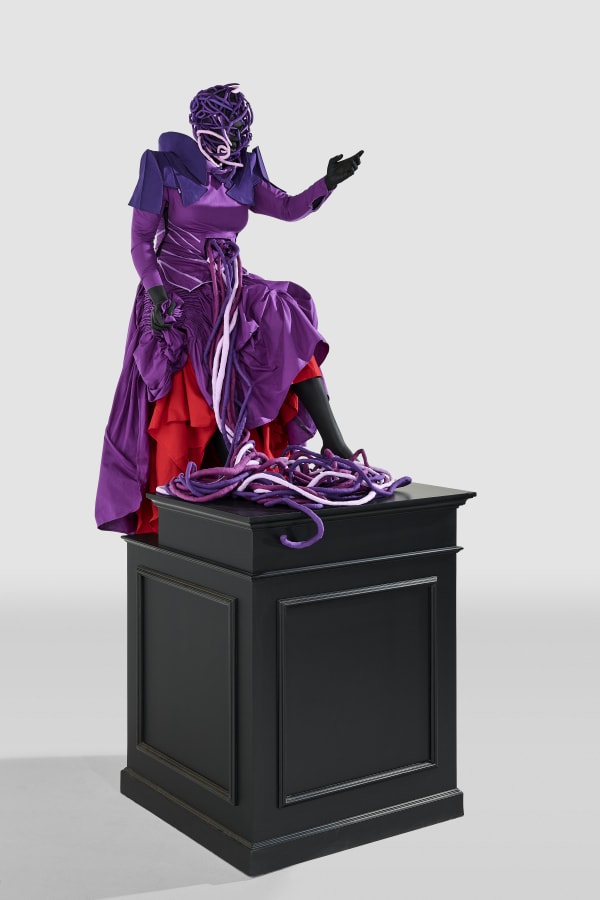-
-
Each February, we set aside time to remember the multitudinous ways Black culture has shaped everyday life for all people in the United States. While celebrating Black History, we also celebrate those artists of color working to construct America’s future.
Since 1968, AFRICOBRA founders Gerald Williams, Jae Jarrell, and Wadsworth Jarrell have worked to synthesize the visual languages of the African diaspora. Their work has always been about envisioning what is to come. The indelible legacy of AFRICOBRA is rooted in the group’s forward-looking philosophy and in the belief that individual artists can help people visualize a better world to come. -
Painted at the height of the AFRICOBRA period, this image celebrates the life of Malcolm X, the giant to whom the title of the painting refers. We see a range of different images showing the humanity of this influential Black leader, including rare scenes with him smiling, pensively studious, laid back and cool. This picture epitomizes the philosophies that informed the foundation of AFRICOBRA, including the ideal of showing proud and positive images of Black heroes, and the ideal of capturing the complex humanity essential to the Black community, subverting the one-dimensional depictions normally associated with figures such as Malcolm X. Aesthetically, we see many formal visual strategies at work, including "Cool-Ade" colors, the use of text, the incorporation of a range of textures, and a mixture of figuration and abstract symbology.
-

-
-

AFRICOBRA 50
Kavi Gupta | 219 N. Elizabeth St. Chicago, IL, 60607 29 September - 27 October 2018Kavi Gupta is pleased to present AFRICOBRA 50, a landmark exhibition of original works by the five founding members of AFRICOBRA—Gerald Williams, Wadsworth Jarrell, Jae Jarrell, Jeff Donaldson, and Barbara... -

AFRICOBRA NATION TIME
Venice Biennale 2019 | La Biennale di Venezia 2019 in Venice, Italy. 11 May - 24 November 2019Kavi Gupta is honored to sponsor AFRICOBRA: Nation Time as an official Collateral Event of La Biennale di Venezia 2019 (May 11th – November 24th 2019), in Venice, Italy.
-
-
From his home base in Atlanta, GA, Alfred Conteh makes stunning paintings that speak critically to the toll white supremacist institutions take on Black Americans, while also showing the resilience and strength that sustain Black culture and communities. Conteh tells the truth of how bad things have been and continue to be, while urging us to open our eyes and press forward.
-

-
-
 Alfred ContehBig Boy, 2020Acrylic and atomized steel dust84 x 47.5 x 3 in
Alfred ContehBig Boy, 2020Acrylic and atomized steel dust84 x 47.5 x 3 in
213.4 x 120.7 x 7.6 cmView more details -
 Alfred ContehJade, 2020Acrylic and urethane plastic on canvas84 x 47.5 x 3 in
Alfred ContehJade, 2020Acrylic and urethane plastic on canvas84 x 47.5 x 3 in
213.4 x 120.7 x 7.6 cmView more details -
 Alfred ContehD-Chris , 2020Acrylic and urethane plastic on canvas84 x 47.5 x 3 in
Alfred ContehD-Chris , 2020Acrylic and urethane plastic on canvas84 x 47.5 x 3 in
213.4 x 120.7 x 7.6 cmView more details
-
-
When Mickalene Thomas first embarked on her art career, she faced an art field largely lacking in positive, inclusive images of femininity—especially images of gay women and women of color. Thomas has worked tirelessly for more than 20 years, constructing a multi-layered, far-reaching oeuvre that powerfully expands public concepts of feminine beauty.
-
Devan Shimoyama makes work that challenges cultural norms and celebrates progress. While acknowledging the pressures he has faced as a gay, Black man, Shimoyama simultaneously explores issues like home buying, gardening, spirituality, and family, spotlighting everyday ways to take ownership of time, community, and culture.
-
-
Born and raised amid the steel yards of south Chicago and the ecological wonderland of Lake Michigan, Richard Hunt pioneered a distinct, abstract visual language that perfectly encapsulates both the natural and built worlds in which he lives and works. What other Chicago abstract artist has ever so completely expressed the dynamic character of their community?
-
-
Kavi Gupta celebrates the diverse perspectives of these, and all artists of color whose work we have the privilege to exhibit and represent, including Dominican-born New York-based artist Firelei Báez, AFRICOBRA member Sherman Beck, conceptual artist Willie Cole, multidisciplinary Haitian, Canadian based artist Manuel Mathieu, South African sculptor, photographer and installation artist Mary Sibande, and abstract sculptor Kennedy Yanko. Along with the curators, historians, critics, teachers, and collectors working to diversify and equalize the contemporary art field, these extraordinary artists exemplify what it means when we say culture is created by communities. Whether equity, justice, and true representation become the norm for all Americans hinges on the thoughts we embrace today and the culture we create right now. Happy Black History Month.
-
-
-
 Mary SibandeAscension of the Purple Figure, 2016Fiberglass, resin, fabric, and steel on painted wood plinth111 3/4 x 39 3/4 x 39 3/4 in
Mary SibandeAscension of the Purple Figure, 2016Fiberglass, resin, fabric, and steel on painted wood plinth111 3/4 x 39 3/4 x 39 3/4 in
284 x 101 x 101 cmView more details -
 Kennedy YankoCreamy Haze, 2020Paint skin and metalSculpture: 34" long x 20" high x 26.5" wide
Kennedy YankoCreamy Haze, 2020Paint skin and metalSculpture: 34" long x 20" high x 26.5" wide
Base: 50.5" long x 31" high x 28.5 in. wideView more details
-



